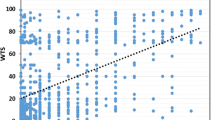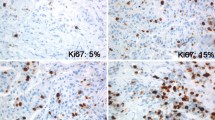Abstract
In our study we have compared the prognostic value of two distinct methods of immunohistochemical Ki-67 determination, tissue microarray (TMA) and classical whole section analysis. “Cut-off” values were used according to the 2009 St. Gallen Consensus. Tissue specimens were obtained from a consecutive retrospective series of 215 female patients with primary invasive tumours. Two hundred and thirteen patients were included in the study. Data on Ki-67 was collected by both tissue microarray (TMA) and whole section analysis. Follow up data on overall (OS) and disease-free survival (DFS) were collected. Median follow-up was 95 months (range from 7.8 through 107 months). Mutual correlation of two Ki-67 determination methods was non-significant (Person’s r = 0.13417; p = 0.0528). There was statistically significant association of whole section Ki-67 expression with histological and nuclear grade, progesterone receptor and HER2/neu status. The expression of Ki-67 protein in TMAs correlated only with histological and nuclear grade, but not with other traditional clinicopathological factors. Statistically significant differences in DFS (p = 0.0156) and OS (p = 0.0028) were confirmed between subgroups with low and high whole section Ki-67 expression. When subgroups with high and intermediate expression were compared, significant difference was found in DFS (p = 0.0272), but not in OS (p = 0.0624). On the other hand, there was no statistically significant difference either in DFS, or in OS, according to the expression of Ki-67 in TMAs (p = 0.6529; p = 0.7883; p = 0.7966 for DFS, and p = 0.8917; p = 0.6448; p = 0.4323 for OS, respectively). In our study, classical whole section was superior to TMA analysis in terms of prognosis and clinicopathological correlation. Our results indicate that the method used may have impact on prognostic significance of Ki-67. Further studies are needed, covering a greater number of patients and including a precisely defined stage and treatment patient cohorts, in order to solve controversies in Ki-67 assessment methodology.






Similar content being viewed by others
References
Gerdes J, Schwab U, Lemke H, Stein H (1983) Production of a mouse monoclonal antibody reactive with a human nuclear antigen associated with cell proliferation. Int J Cancer 31:13–20
Bullwinkel J, Baron-Luhr B, Ludemann A, Wohlenberg C, Gerdes J, Scholze T (2006) Ki67 protein is associated with ribosomal RNA transcription in quiescent and proliferating cells. J Cell Physiol 206:624–635
Rahmanzadeh R, Huttmann G, Gerdes J, Scholzen T (2007) Chromophore-assisted light inactivation of pKi67 leads to inhibition of ribosomal RNA synthesis. Cell Prolif 40:422–430
Scholzen T, Gerdes J (2000) The Ki- 67 protein: from the known and the unknown. J Cell Physiol 182:311–322
Brown DC, Gatter KC (2000) Ki67 protein: the immaculate deception? Histopathology 40:2–11
Lopez F, Belloc F, Lacombe F et al (1991) Modalities of synthesis of Ki67 antigen during the stimulation of lymphocytes. Cytometry 12:2–49
Cattoretti G, Becker MH, Key G et al (1992) Monoclonal antibodies against recombinant parts of the Ki-67 antigen (MIB 1 and MIB 3) detect proliferating cells in microwave-processed formalin-fixed paraffin sections. J Pathol 168:357–363
Veronese SM, Maisano C, Scibilia J (1995) Comparative prognostic value of Ki-67 and MIB-1 proliferation indices in breast cancer. Anticancer Res 15(6B):2717–2722
Urruticoechea A, Smith IE, Dowsett M (2005) Proliferation marker Ki-67 in early breast cancer. J Clin Oncol 23:7212–7220
Shoker BS, Jarvis C, Clarke RB et al (1999) estrogen receptor-positive proliferative cells in normal and precancerous breast. Am J Pathol 155:1811–1815
Okumura Y, Yamamoto Y, Zhang Z et al (2008) Identification of biomarkers in ductal carcinoma in situ of the breast with microinvasion. BMC Cancer 8:287
Wintzer HO, Zipfel I, Schulte-Monting J et al (1991) Ki-67 immunostaining in human breast tumours and its relationships to prognosis. Cancer 67:421–428
Spyratos F, Ferrero-Pous M, Trassard M et al (2002) Correlation between MIB-1 and other proliferation markers: clinical implications of the MIB-1 cutoff value. Cancer 94:2151–2159
Rudolph P, Olsson H, Bonatz G et al (1999) Correlation between p53, c-erbB-2, and topoisomerase II alpha expression, DNA ploidy, hormonal receptor status and proliferation in 356 node-negative breast carcinomas: prognostic implications. J Pathol 187:207–216
Trihia H, Murray S, Price K et al (2003) Ki-67 expression in breast carcinoma: its association with grading systems, clinical parameters, and other prognostic factors – a surrogate marker? Cancer 97:1321–1331
Tan PH, Bay BH, Yip G, Selvarajan S, Tan P, Wu J, Lee CH, Li KB (2005) Immunohistochemical detection of Ki67 in breast cancer correlates with transcriptional regulation of genes related to apoptosis and cell death. Mod Pathol 18(3):374–381
Yerushalmi R, Woods R, Ravdin PM, Hayes MM, Gelmon KA (2010) Ki67 in breast cancer: prognostic and predictive potential. Lancet Oncol 11(2):174–183
Wiesner FG, Magener A, Fasching PA, Wesse J, Bani MR, Rauh C, Jud S, Schrauder M, Loehberg CR, Beckmann MW, Hartmann A, Lux MP (2009) Ki-67 as a prognostic molecular marker in routine clinical use in breast cancer patients. Breast 18:135–141
Neri A, Marrelli D, Pedrazzani C, Caruso S, De Stefano A, Mariani F, Megha T, De Marco G, Corso G, Pinto E, Roviello F (2008) Prognostic relevance of proliferative activity evaluated by Mib-1 immunostaining in node negative breast cancer. EJSO 34:1299–1303
Goldhirsch A, Ingle JN, Gelber RD, Coates AS, Thurlimann B (2009) Senn HJ & Panel members 2009 thresholds for therapies: highlights of the St Gallen International expert consensus on the primary therapy of early breast cancer. Ann Oncol 20:1319–1329
Elston CW, Ellis IO (1987) Pathological prognostic factors in breast cancer. I. the value of histological grade in long- term prognosis of breast cancer: a study of 1010 patients, uniformly treated at the institute Gustave-Roussy. J Clin Oncol 5:1378–1386
Elston CW, Ellis IO (1991) Pathological prognostic factors in breast cancer. The value of histological grade in breast cancer: experience from a large study with long-term follow-up. Histopathology 19:403–410
Carreno G, del Casar JM, Corte D et al (2007) Local recurrence after mastectomy for breast cancer: analysis of clinicopathological, biological and prognostic characteristics. Breast Cancer Res Treat 102:61–73
Ruiz C, Seibt S, Al Kuraya K et al (2006) Tissue microarrays for comparing molecular features with proliferation activity in breast cancer. Int J Cancer 118:2190–2194
Dowsett M, Nielsen TO, A’Hern R et al (2011) Assessment of ki67 in breast cancer. J Natl Cancer Inst 103(22):1656–1664
Honma N, Horii R, Iwase T et al (2013) Ki-67 evaluation at the hottest spot predicts clinical outcome of patients with hormone receptor-positive/HER2-negative breast cancer treated with adjuvant tamoxifen monotherapy. Breast Cancer. doi:10.1007/s12282-013-0455-5
Wersto RP, Liblit RL, Deitch D, Koss LG (1991) Variability in DNA measurements in multiple tumour samples of human colonic carcinoma. Cancer 67:106–115
Gerlinger M, Rowan AJ, Horswell S et al (2012) Intratumour heterogeneity and branched evolution revealed by multiregion sequencing. NEJM 366:883–892
Jones RL, Salter J, A’Hern R et al (2010) Relationship between oestrogen receptor status and proliferation in predicting response and long-term outcome to neoadjuvant chemotherapy for breast cancer. Breast Cancer Res Treat 119(2):315–323
Fasanella S, Leonardi E, Cantaneli C et al (2011) Proliferative activity in human breast cancer: Ki-67 automated evaluation and the influence of different Ki-67 equivalent antibodies. Diagn Pathol 6(Suppl 1):S7
Mohammed ZMA, McMillan DC, Elsberger B et al (2012) Comparison of visual and automated assessment of Ki-67 proliferative activity and their impact on outcome in primary operable invasive ductal breast cancer. Br J Cancer 106:383–388
Cheang MC, Chia SK, Voduc D, Gao D, Leung S, Snider J (2009) Ki67 index, HER2 status, and prognosis of patients with luminal B breast cancer. J Natl Cancer Inst 101:736–750
Stuart-Harris R, Caldas C, Pinder SE, Pharoah P (2008) Proliferation markers and survival in early breast cancer: a systematic review and meta-analysis of 85 studies in 32,825 patients. Breast 17:323–334
de Azambuja E, Cardoso F, de Castro JG et al (2007) Ki-67 as prognostic marker in early breast cancer: a meta-analysis of published studies involving 12,155 patients. Br J Cancer 96:1504–1513
Colozza M, Azambuja E, Cardoso F, Sotiriou C, Larsimont D, Piccart MJ (2005) Proliferative markers as prognostic and predictive tools in early breast cancer: where are we now? Ann Oncol 16:1723–1739
CuzickJ DM, Pineda S et al (2011) Prognostic value of a combined estrogen receptor, progesterone receptor, ki-67, and human epidermal growth factor receptor 2 immunohistochemical score and comparison with the genomic health recurrence score in early breast cancer. J Clin Oncol 29:4273–4278
Ishihara M, Mukai H, Nagai S et al (2013) Retrospective analysis of risk factors for central nervous system metastases in operable breast cancer: effects of biologic subtype and ki67 overexpression on survival. Oncology 84:135–140
Penault-Llorca F, Andre F, Sagan C et al (2009) Ki67 expression and docetaxel efficacy in patients with estrogen receptor–positive breast cancer. J Clin Oncol 27:2809–2815
Viale G, Regan MM, Mastropasqua MG et al (2008) Predictive value of tumour ki-67 expression in two randomized trials of adjuvant chemoendocrine therapy for node-negative breast cancer. J Natl Cancer Inst 100:207–212
Viale G, Giobbie-Hurder A, Regan MM et al (2008) Prognostic and predictive value of centrally reviewed Ki-67 labeling index in postmenopausal women with endocrine responsive breast cancer. results from breast international group trial 1–98 comparing adjuvant tamoxifen with letrozole. J Clin Oncol 26:5569–5575
Dowsett M, Dunbier AK (2008) Emerging biomarkers and new understanding of traditional markers in personalized therapy for breast cancer. Clin Cancer Res 14:8019–8026
Dowsett M, Smith IE, Ebbs SR et al (2007) Prognostic value of Ki67 expression after short-term presurgical endocrine therapy for primary breast cancer. J Natl Cancer Inst 99(2):167–170
Rimm DL, Camp RL, Charette LA et al (2001) Tissue microarray: a new technology for amplification of tissue resources. Cancer J 7:24–31
Eerola H, Heikkilä P, Tamminen A, Aittomäki K, Blomqvist C, Nevanlinna H (2005) Relationship of patients’ age to histopathological features of breast tumours in BRCA1 and BRCA2 and mutation-negative breast cancer families. Breast Cancer Res 7:R465–R469
Acknowledgments
This work was supported by the Ministry of Science, Education and Sports, Republic of Croatia (grant 108-1080058-0046).
Declaration of Interest
The authors report no conflicts of interest. The authors alone are responsible for the content and writing of the paper.
Author information
Authors and Affiliations
Corresponding author
Rights and permissions
About this article
Cite this article
Dedić Plavetić, N., Jakić-Razumović, J., Kulić, A. et al. Prognostic Value of Ki-67 in Breast Carcinoma: Tissue Microarray Method Versus Whole Section Analysis- Potentials and Pitfalls. Pathol. Oncol. Res. 21, 315–324 (2015). https://doi.org/10.1007/s12253-014-9823-5
Received:
Accepted:
Published:
Issue Date:
DOI: https://doi.org/10.1007/s12253-014-9823-5




